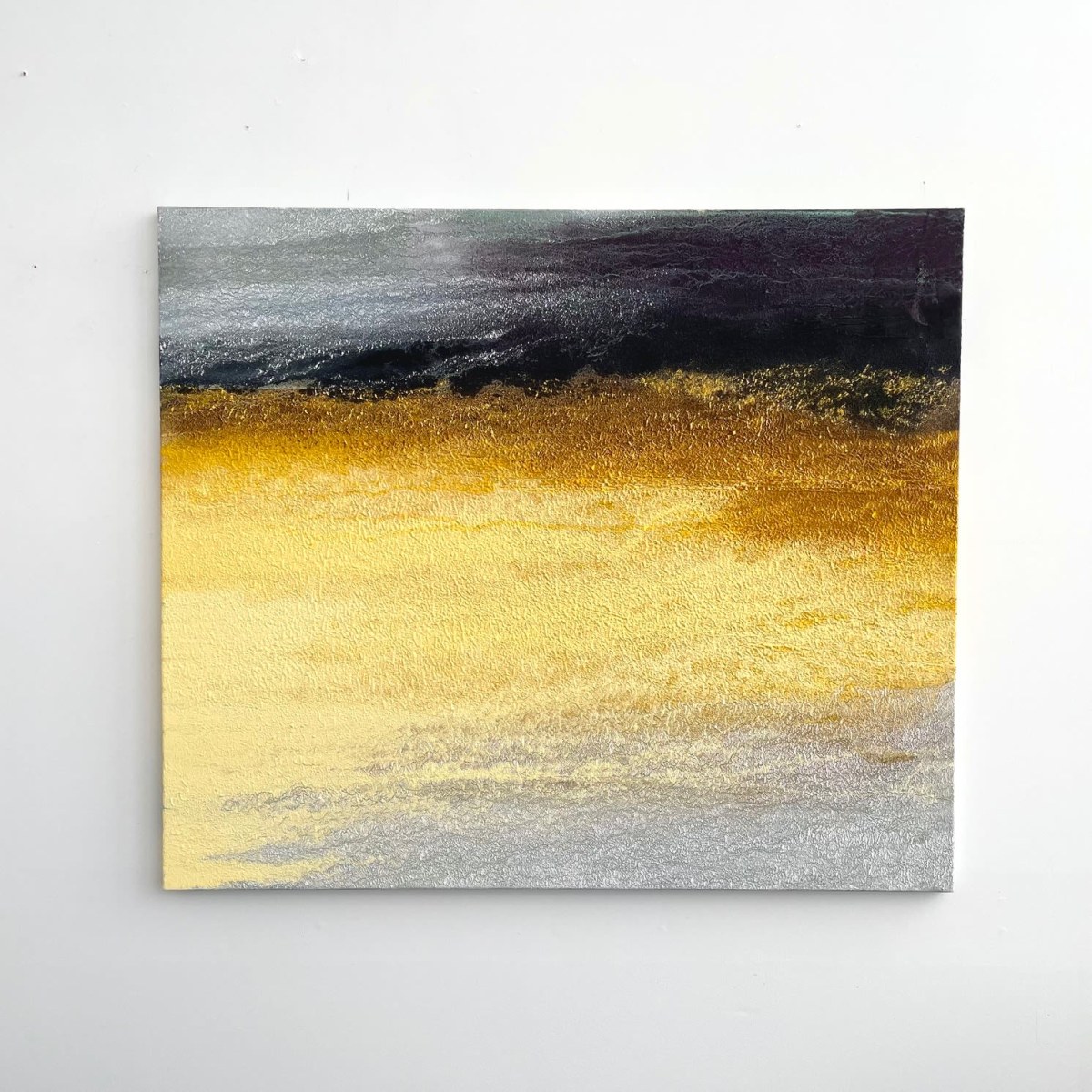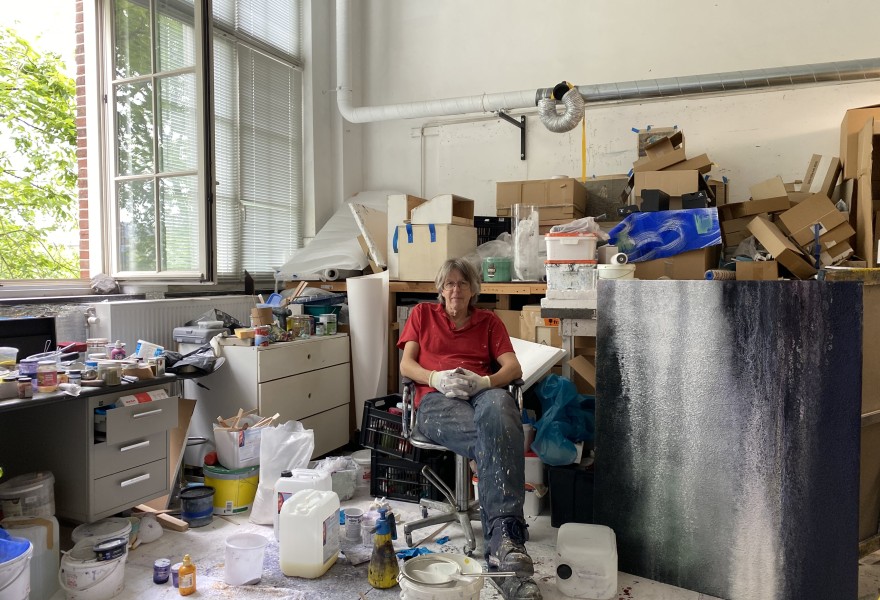20 june 2025, Wouter van den Eijkel
The studio of... Kees de Vries
Last week I visited Kees de Vries in his studio, located in the former Sint Vincentius School on one of the Eastern Islands in Amsterdam. The school building, dating from 1921, still has its original staircase and tiling, but the classroom where De Vries’ studio is situated has been made entirely functional.
De Vries is known on the one hand for his paintings in which he fixes pure pigments onto canvas, and on the other for works made entirely of salt — a material that was initially difficult to stabilise but offered endless possibilities once he succeeded in doing so. He has created large panels with it, as well as sculptures of tables, plates, glasses, and cutlery.
Where exactly are we?
My studio is in a former school building on one of the Eastern Islands in Amsterdam. As you’ve seen, the staircase is still completely original, but inside I’ve painted, rebuilt, and adjusted everything at least three times.
Originally the building belonged to a foundation, but there was a great deal of overdue maintenance. As a result, in the early 1980s, the municipality acquired it for the symbolic price of one guilder. That’s when we (a group of six artists) moved in, each with five-year contracts. These contracts kept being extended.
Over the years, the manager has become stricter about checking whether artists have a professional practice (making art, selling work, and exhibiting) to prevent misuse of the spaces intended as studios.

Kees de Vries, Covered by Beauty # 7, 2023, Galerie Franzis Engels
How long have you been working in this former classroom?
I’ve been here for about 43 years now. Over such a span of time, you build an entire life here.
Some colleagues say they are only productive for a few hours a day, so they stop after that. But there are also those who work twelve-hour days. How is that for you?
I usually start at nine and work until at least five. But if I’m in a good flow, I’ll often carry on for a few more hours. Steady as she goes. I quite enjoy the mornings.
Do you have any routines or rituals that shape the course of your day? Do you start with coffee? Do you listen to particular music?
No, I usually don’t eat or drink anything here — partly because I live very close by and don’t want to be tempted to have coffee here too, and partly because I work with a lot of dusty materials.
I usually work with music on or tuned to a classical radio station. It serves as background noise. You get that anyway here, as I’m on a busy road and you can hear the sounds of the city.

Kees de Vries, ZT 2025 02, 2025, Galerie Franzis Engels
If I judge correctly, you hardly ever receive visitors here. Everything seems designed for just one person?
Yes, that’s right. If people drop by, it disrupts my process. That’s why I always welcome visitors at home in the gallery.
You work a lot with salt and pigments. Can you tell me when you started working with salt and why?
I actually started very early, back at the academy in 1979. I began using salt in collages. I wanted to work with pure white crystals — I found them fascinating. Crystals are very difficult to work with. If you try to fix them with glue, the glue discolours and the salt loses its brilliant white shine. Sugar was no good because it turned sticky. But after a lot of experimenting, I managed to make panels with salt crystals that still looked untouched. Because it was so tricky in the beginning, I did put it aside for a while.
When did you pick it up again?
Only around 2000, when new products came onto the market — special art resins. These resins stay flexible, are strong, and do not discolour. From then on I regularly did tests with them. I just hang them right here in the window. This sheet has been hanging in full sunlight since 2010 — constantly. It’s still perfectly clear.
I understand that you then stopped working with pigments for a while and fully devoted yourself to working with salt — is that right?
Yes, I thought: now that I finally have this binder, I’m going to use it. So for 15 years I focused solely on working with salt. At first I only made salt panels, but later on other forms and different narratives emerged.

Kees de Vries, Engel der barmhartigheid, 2021, Galerie Franzis Engels
What is the most eye-catching object you have made with salt?
My idea was to make a 180 cm table with matching chairs, entirely from salt. The tabletop had a basin which I filled daily with saltwater. After a while, the salt would grow from the basin over the entire table. The table would be set with tableware like bottles, plates, and glasses — all made from pure salt. A striking image that evokes many different stories and emotions. The process of making all of that is very time-consuming, but by now I have quite a stock of salt tableware. Unfortunately, the table itself didn’t survive. But the chairs turned out well and have been acquired by private collections and exhibited in France and Germany.
What happened to the table?
I filled the basin with tap water mixed with sea salt. But the tap water in Amsterdam contains minuscule particles of iron. This reacted with the salt, causing the table to become blotchy. The rusted salt looked a bit like a dog had peed in the snow.
Being an artist isn’t a normal job where you retire at 67. An artist never really has to stop. Do you have any points of focus — things you’d still like to do in the coming years?
I don’t really have a focus, but actually, I’ve never had one. My ambition has always been — and still is — to make art. I’ve always been full of ideas, and that keeps driving me back to the studio. In that sense, I’m a true maker. I do notice that in recent years I’ve become more selective when it comes to accepting opportunities that come my way. But as far as the work itself is concerned, it’s the same. I’m just as passionate as ever and still put the same energy into it.
Do you have any tips for beginning artists? What pitfall would you warn them about?
Look, when you start as an artist, success doesn’t come overnight. At some point you’ll run into the fact that you need to pay rent and buy materials. The moment you start earning money outside your artistic practice is a big pitfall. I’m quite handy, so I was doing odd jobs and building things. If you’re not careful, you end up spending more time on that work than on your art and hardly ever get into the studio. Then it becomes hard to set boundaries for yourself. Like: “Whoa, stop! Back to the studio now!”
It’s also important to keep exhibiting. If you don’t actively pursue that and just wait for someone to ask you, it can take a very long time. So you need to be proactive in organising your own career. I managed to secure a gallery in Amsterdam as early as 1984. And soon after, other galleries approached me as well.
The work of Kees de Vries can be seen at Galerie Franzis Engels in Amsterdam. The gallery will be open as usual this coming week. From 1 July, visits will be by appointment only.
